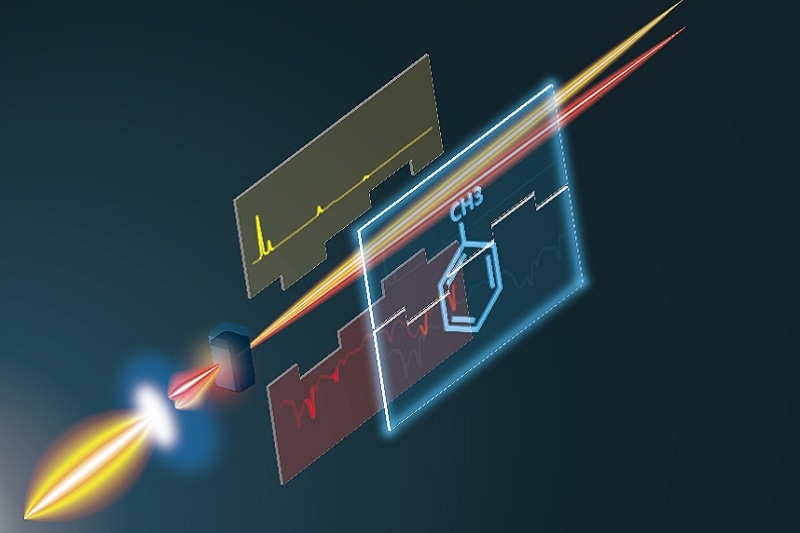Oct 1 2019
An innovative tool has been developed by scientists for studying molecules with the help of a crystal, a laser, and light detectors.
 Artist’s representation of complementary vibrational spectroscopy. The new technique of complementary vibrational spectroscopy relies on improvements in ultrashort pulsed laser technology. (Image credit: © Takuro Ideguchi, CC BY-ND-4.0)
Artist’s representation of complementary vibrational spectroscopy. The new technique of complementary vibrational spectroscopy relies on improvements in ultrashort pulsed laser technology. (Image credit: © Takuro Ideguchi, CC BY-ND-4.0)
This latest technology will expose nature’s tiniest sculptures, that is, molecular structures, with improved specificity and detail.
We live in the molecular world where most things around us are made of molecules: air, foods, drinks, clothes, cells and more. Studying molecules with our new technique could be used in medicine, pharmacy, chemistry, or other fields.
Takuro Ideguchi, Associate Professor, Institute for Photon Science and Technology, The University of Tokyo
The latest method integrates a pair of existing technologies into a single exclusive system known as complementary vibrational spectroscopy. The movement of the atoms’ nuclei causes small yet distinctive vibrations in all molecules.
Spectrometers are tools that can identify the way those vibrations cause molecules to scatter or absorb light waves. Existing spectroscopy methods are restricted by the type of light that can be measured by them.
The latest complementary vibrational spectrometer created by Japanese researchers is capable of measuring a broader spectrum of light. It integrates the more reduced spectra of two other tools known as Raman scattering and infrared absorption spectrometers. The combination of both spectroscopy methods offers scientists different yet complementary data about the vibrations of molecules.
We questioned the ‘common sense’ of this field and developed something new. Raman and infrared spectra can now be measured simultaneously.
Takuro Ideguchi, Associate Professor, Institute for Photon Science and Technology, The University of Tokyo
Conventional spectrometers can only identify light waves with lengths ranging between 2.5 and 25 µm (infrared spectroscopy) or between 0.4 and 1 µm (Raman spectroscopy). There was a gap between these two techniques, which indicated that infrared and Raman spectroscopy had to be carried out individually. This restriction is like attempting to enjoy a duet, but being compelled to listen to both the parts individually.
Light waves around the visible to mid-infrared and near-infrared spectra can be detected by complementary vibrational spectroscopy. Now, complementary vibrational spectroscopy has become possible, thanks to developments in ultra-short pulsed laser technology.
A titanium-sapphire laser within the complementary vibrational spectrometer transmits pulses of near-infrared light with the width of 10 quadrillionths of a second or 10 fs towards the chemical sample. Prior to striking the sample, the light is directed to a gallium selenide crystal. Mid-infrared light pulses are then produced by the crystal.
Following this, the mid-infrared and near-infrared light pulses are directed to the sample, and the scattered and absorbed light waves are subsequently identified by photodetectors. Finally, these light waves are concurrently changed into infrared and Raman spectra.
To date, the scientists have tested their latest method only on samples of pure chemicals that are often found in science laboratories. But going forward, they believe that the method will be used to figure out the way molecules alter their shape in real time.
Especially for biology, we use the term ‘label-free’ for molecular vibrational spectroscopy because it is noninvasive and we can identify molecules without attaching artificial fluorescent tags. We believe that complementary vibrational spectroscopy can be a unique and useful technique for molecular measurements.
Takuro Ideguchi, Associate Professor, Institute for Photon Science and Technology, The University of Tokyo